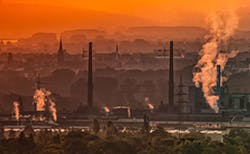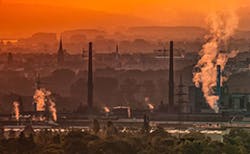Mobile Air Quality Vans Track Pollution In U.K.
Industrial air pollution
Scientists at the Universities of Birmingham, Manchester, Cranfield and Coventry, Imperial College London and Aston University secure NERC funding for two “supersite observatories’” – fixed in an electric van and a trailer – that will dovetail with existing fixed air quality supersites in Birmingham, London and Manchester. As part of the drive to improve regional and national air quality, the mobile supersites will help scientists better understand the balance between traffic and urban emissions, and pollutants already present in the air and carried on the wind into urban areas. They will also help to define how chemical processing agricultural emissions and changes to move towards carbon-zero transport affect air quality.
Urban Air Quality Supersites already allow researchers to gather detailed data on the contents of harmful urban air pollution, working out where the gases and particles that pollute the air are coming from and how they form in the air – adding observational capacity far beyond the routine DEFRA and local authority air quality monitoring. Poor air quality arises from the interaction of emissions, weather and atmospheric processes, affecting the amounts and toxicity of pollutants.
“Air pollution is the biggest environmental risk in the U.K., leading to significant health inequalities and costing the country’s economy some £20 billion every year,” says Zongbo Shi, professor of atmospheric biogeochemistry at the University of Birmingham. “Adding mobile ‘supersite observatories’ to the monitoring capacity provided by our fixed sites will take our capability for quantifying air pollution sources and processes to the next level and consolidating Britain’s world-leading position in this field.
He adds, “This exciting development will produce policy-relevant science with significant impact – informing air quality policy and helping to account for imported emissions. This is a U.K.-based approach with potential for global impact.”
Backed by £1.3 million of NERC funding, the new supersites are not traditional monitoring stations. They reportedly will comprise highly sophisticated instruments that monitor key species in atmospheric processes, including:
- Trace metals, nanoparticles and particle composition, plus regulated gas pollutants.
- Volatile organic compounds (VOCs) – key to ozone, secondary organic aerosol and new particle formation; and
- Ammonia - key to aerosol formation.
The mobile units will help to create the U.K. Air Quality Supersite Triplet (UK-AQST) configuration: rural, urban and roadside. This will allow urban and roadside concentration increments to be measured, as well as processing polluted air to analyze key secondary pollutants such as nitrates, organic particles and nanoparticles in unprecedented detail. Forthcoming revision of World Health Organization guidelines will inform revised national air quality targets, within the new Environment Bill. According to the University of Birmingham, UK-AQST will directly benefit the U.K.'s atmospheric and environmental health community with six institutions involved.
For more information, visit: www.birmingham.ac.uk

